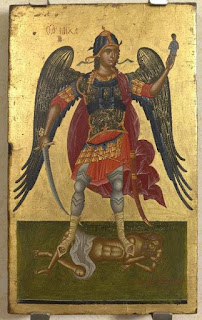In Osprey Men-at-Arms series' "the Varangian Guard 988-1453" a Cretan guardsman is depicted.[1]
The soldier supposedly belongs to the Cretan Guard who fought in the final siege of Constantinople in 1453.
The source mentioned is an icon from Megali Panagia in Patmos island. [7]
1. Cretan archer. Osprey's "the Varangian guard"
Searching the subject, we discovered many icons of military saints with an almost identical clothing and equipment. [2][3][5][6][7]
Saint Theodore Teron, saint George, saint Merkourios and saint Fanourios all members of the same guard?
They wear a richly decorated cuirass- probably of hard leather-with pteryges for their waist, pinkish boots and even trousers with the same square piece of cloth on the knees.
Inside the leather corslet a long sleeved mail hauberk is worn and also rerebraces for the protection of the upper arms.
Weapons include sword, spear, bow and cuiver and round or square shield.
2.An excellent st.Theodore Stratelates slaying the dragon
3.st.Fanourios
Both works of Angelos Akotantos -15th century. From Athens byzantine museum and Heraklion icon gallery
The best and earliest of these works are signed by the painter Angelos Akotantos who lived and worked in Venetian Crete in the first half of the 15th century.
Some other icons seem to be later copies of his works (second half 15th-16th century). [5][6]
So, the question is : Could this be a realistic image of the Cretan warrior?
Let's face the facts...
Around 1450, Crete was already nearly 250 years under Venetian rule. In the Roman empire of the time, the army consisted of foreign mercenaries, few thousands of militia and city guardsmen and a handful of imperial guards and nobles.
After the civil wars and the Serbian and Ottoman conquests- already since the 1370's- the local smiths and workshops stopped producing byzantine weapons and armors in large scale.
Probably the few rich nobles and guardsmen carried Italian or Turkish weapons.
The corslet of these saints seems rather an artistic conception. Copying the older byzantine and ancient style of cuirass with pteryges, it does not seem possible for this era.
Same goes for the wrapped boots.
Already since the 13th century a turn to unrealistic ancient looking depiction of military saints is obvious in byzantine art.
Akotantos follows this trend, in several other of his known works. [8][9]
On the other hand he seems to have painted some of the body armor and the weapons like the ones of his time.
In Archangel Michael icon, the leg protection, as well as the sabre seem contemporary.
In the icons under discussion, the mail shirt, the rerebraces, the sword and some shields could certainly be part of a 15th century Cretan warrior's armor.
Especially these hardened leather rerebraces were popular among Venetian nobles about a century earlier. The light armed locals may continued using them.
4."Knight Collalto" - mid 14th century. Osprey's "the Venetian Empire", plate B
5,6.Saint George killing the dragon, Saint George and Saint Mercurius. 16th century icons. Imitation of Akotantos' prototypes.
7.The original of Osprey's plate. Saint Fanourios. Fine work of Angelos Akotantos. 15th century
8.Another depiction of st. Fanourios by the same artist. Body armor here is a stylized byzantine klivanion of earlier centuries.
9.Archangel Michael and the rich man. Here, the artist combines the unrealistic body armor with the contemporary plate leg protection. (combination with the wrapped boots seems funny)
10.Evangelist Mark -protector of Venice- as a cardinal with his symbol, the lion.
Angelos Akotantos, mid 15th century


11. 12.
PS: In the same edition, we spotted some more fails, like the polearm-sickle rhomphaia of the Varangians [11] and the weird weapon of Megalodiermineutis [12] based on an ill-shaped seal.[13]


11. 12.
13.











Hi! There is a 14th century painting from the school of Siena that shows an armour very close to those of the painter Angelos, take a look:
ΑπάντησηΔιαγραφήhttps://artsandculture.google.com/asset/st-michael-and-the-dragon/9gHUaR9XS727lg